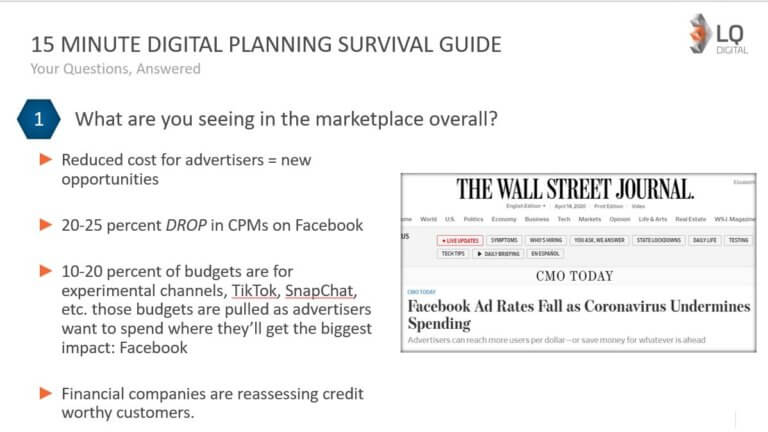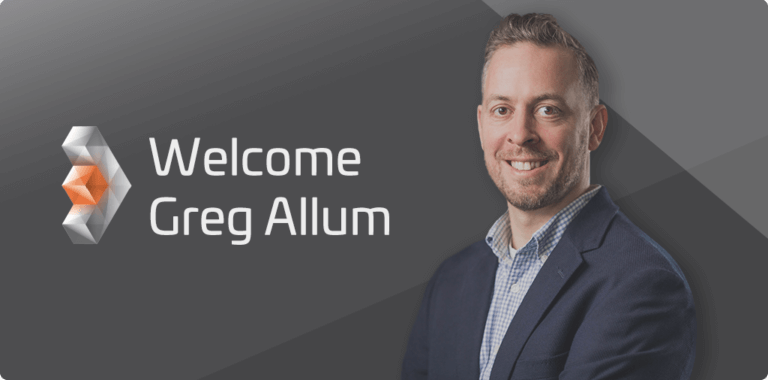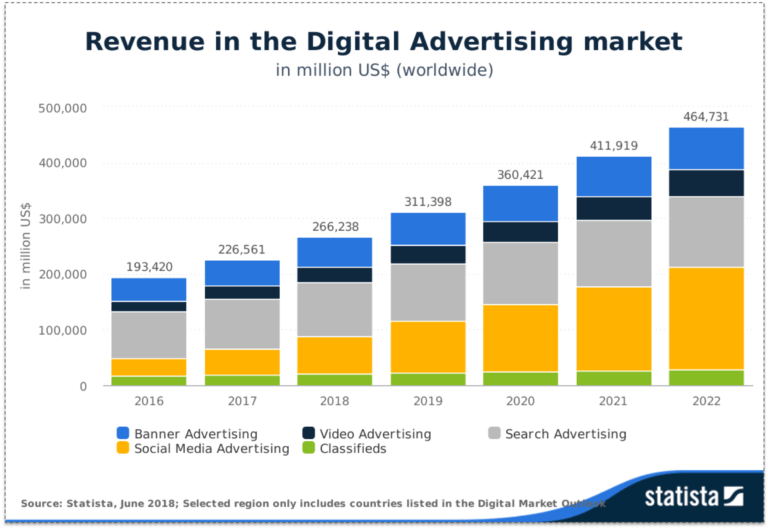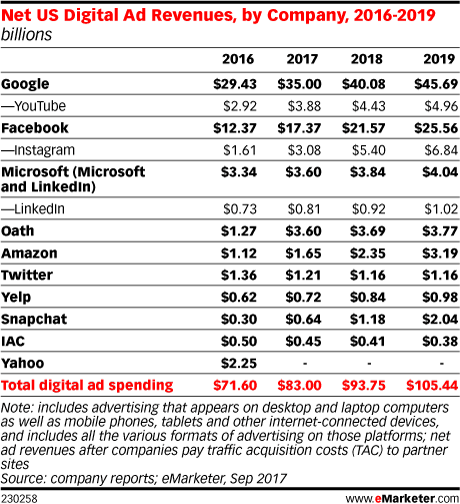The Impact of Coronavirus on Paid Social, Your Questions Answered
Last week, we launched the first episode in our 15 Minute Digital Planning Guide webinar series. As part of our goal to help businesses navigate the changing landscape of digital media during the Coronavirus pandemic, our weekly webinar series is aimed to provide insight, share trends and provide practical tips for marketers to implement now.
In the first episode we interviewed our own VP of Display & Social, Greg Allum for our Paid Social: Part 1 Edition. We gathered his perspective on the impact Coronavirus has had on Paid Social and what companies can expect moving forward. You can view the webinar here.
This week, we’re continuing our interview with Greg Allum and asking him your most pressing questions. Learn valuable insight that can impact your business now, such as:
- The surprising advertising opportunities made available since the Coronavirus impact.
- Current advertising response methods for clients – plus an unexpected emerging one.
- Insight as to what types of businesses may want to suspend advertising and which ones may want to invest.
- Top recommendations for social.
At LQ Digital, we have over 15 years of digital media, strategy & data management experience and have deep expertise in working with clients in B2C subscription, mortgage lending, B2B, Real Estate, Personal Loans and so much more. As such, we’ve captured a lot of data on what scores as best-in-class digital performance (search, social, affiliate). At this time we want to contribute in the only way we know how, to share our data, knowledge and expertise to help your company survive this turbulent time and provide relief. Please watch the webinar for free here:
Digital Survival Guide Webinar: Paid Social, Part 2

Still have questions or want a us to cover a particular topic? Email us at ehoffman@lqdigital.com and remember to subscribe to our webinar series so you always have the latest news and insight in your inbox: subscribe here.
15 Minute Digital Planning Webinar: Paid Social in the Time of Coronavirus
We understand this is an extremely challenging time – but your business doesn’t have to come to a screeching halt. In fact, businesses and consumers still need supplies & resources – their needs are just shifting and they’re moving almost exclusively to digital channels.
Now is the time to take action, be nimble to that shift and shore-up your digital strategy. We want to be your ally. As our contribution to help during this crisis, we are kicking off a series of webinars focused on survival strategies, insight and practical tips from our own digital experts as well as partners. Each week, we’ll host a 15 minute webinar (give or take) with rotating topics, to help you navigate these strange times we’re finding ourselves in.
In the first episode of our webinar series we interviewed our own VP of Display & Social, Greg Allum for our Paid Social: Part 1 Edition. We gathered his perspective on the impact Coronavirus has had on Paid Social and what companies can expect moving forward, such as:
- How Coronavirus is impacting social usage & engagement
- How marketers are currently responding to the crisis
- How advertising during a recession can actually help businesses
- The importance of creative & messaging
At LQ Digital, we have over 15 years of digital media, strategy & data management experience and have deep expertise in working with clients in B2C subscription, mortgage lending, B2B, Real Estate, Personal Loans and so much more. As such, we’ve captured a lot of data on what scores as best-in-class digital performance (search, social, affiliate). At this time we want to contribute in the only way we know how, to share our data, knowledge and expertise to help your company survive this turbulent time and provide relief. Please watch the webinar for free here:
Digital Survival Guide Webinar: Paid Social, Part 1
Still have questions or want a us to cover a particular topic? Email us at ehoffman@lqdigital.com and remember to subscribe to our webinar series so you always have the latest news and insight in your inbox. Subscribe here.
3 Pillars To Optimize Performance Under HEC

It’s been almost a year since I last covered how it’s possible to ‘target’ without personalization on Facebook. Now I’d like to share what we’ve learned at LQ Digital when it comes to targeting in this new age of Facebook restrictions.
Background
Facebook adopted HEC restrictions on March 19th following the civil rights lawsuit with the National Fair Housing Alliance (NFHA), Communications Workers of America (CWA), and several other organizations. As part of their settlement, Facebook agreed to make significant changes in how businesses target individuals. One significant change included creating a separate advertising portal for ads focused on housing, employment and credit cards – that limited the targeting options for these advertisers and instead, create a lookalike ‘lite’ tool called ‘Similar Audiences’. This is in addition to removing the ability for these advertisers to target audiences based on age, gender, and zipcode.
Now, certainly advertisers expected a bit more regulation after the Cambridge Analytics scandal – but at times, removing some of these targeting options can be challenging for our clients. For example, if you’re setting up an advertising campaign for mortgage lenders that want to target potential homebuyers – it wouldn’t make sense to target an 18 year old, they aren’t in the market to buy a home. They probably don’t even care to see the ad. Yet we can’t filter that out as directly as we’ve been able to in the past.
So how can we reach the needs of our clients and the end users with these new regulations?
How to Reach Customers Without Targeting
The feedback from Facebook is “target broadly and trust our algorithm” meaning they’ll identify the signals of potential buyers without your need to target them explicitly. The problem is, when testing this out budgets need to be sufficient to allow the algorithm to learn these signals. The math of this can be quite challenging especially if leads can be in the region of $250. Testing 2x Ad Sets based on Facebook’s 50 conversion in 7 days means you’d need to invest $25,000 to gain a statistical significant outcome.
For example, before HEC regulations, agencies could shortcut the Facebook algorithm learning through smart targeting options – but now we are facing more challenges by allowing the algorithm to find those signals by itself. It does figure that out quickly, but the industry as a whole saw a 15-20 percent drop across the platform. This is simply because agencies had to target more people for the algorithm to have enough data to do the learning. That hurts, especially when clients are looking at the ROI of their media dollar.

At LQ digital, we’ve done our own multi-variant tests. By adopting a strategic approach to segments and audiences through insightful research, we can expedite performance. Another strategy we took was to optimize for the highest possible conversion event with the most volume of signal – too small a data set can be detrimental to algorithmic learning in the platform. If a customer clicked on an ad and went to a website to fill out a form for a loan, what we as advertisers would do is put pixels on that website to show that person converted and then send the signal back into Facebook to determine variances between high-value customers. With that, we were able to mitigate risks for our clients and avoid the 20 percent downturn that many advertisers experienced.
As a preferred Facebook partner, we worked closely with Facebook to identify ways to improve performance in spite of these regulations. We’ve found that the Facebook algorithm works well and has improved considerably in the last 18 months. We’ve taken our findings and outlined 3 key pillars to optimize performance with these guidelines.
1. Optimize for Signal Based Targeting
I can’t stress this enough. You want to optimize toward the lowest conversion point you possibly can with the most volume, so the algorithm can find more of those customers. Of course, most clients want that – but the volume may not be enough to drive algorithmic learning. If you optimize too high in the level – that signal isn’t strong enough. You need the right mix between volume and signal.
2. Adopt an Aggressive Bidding Strategy
Adopt advanced bidding strategy in the auction. With a lot of HEC companies, like financial services, the content is less engaging. For example, you might be targeted with content by Nike or ecommerce brands everyday. Facebook doesn’t discriminate, they will show you both ads and advertisers win or lose by the ranking system Facebook implements. As you can imagine, buying shoes isn’t a big decision (for most!). The decision to cashout equity in a house, or take on a new loan is a more considered process. The less impulsive the lower the Estimated Action Rate (EAR) Facebook’s algorithm will attribute to your ad. Therefore, the conversion overall is going to be lower for those types of companies. If you’re already up against those ads since you’re competing against higher engaging brands, you have to win the auction. Your bidding strategy has to be aggressive enough so that your ads get shown enough against the other brands – that means switching from automated or lowest cost bidding and using a Cost or Bid Cap strategy, which can guarantee more consistent delivery of impressions.
3. The Art of Beautiful
According to Nielson, 56 percent of all performance in social is attributed to creative. Financial Services brands are conservative in comparison to a majority of other advertisers, therefore creating compelling and engaging assets for personal loans isn’t common. That doesn’t mean you should ignore the power that imagery and video can have. At LQ Digital, we developed a framework and set of principles called the ‘Art of Beautiful’. An example would be the overuse of stock photography, which by definition is already fatigued. We seek creative that aligns to core photography principles ie. The Rule of Thirds or The Golden Ratio and is visually compelling so it has an interesting impact on the newsfeed.
By putting these 3 pillars together – signal based targeting, bidding strategy and creative, we saw performance rebound back to the levels that they were before the HEC regulations – and we’ve become better advertisers as a result.
Questions? Contact us, we’re happy to help.
LQ Digital taps Greg Allum as Vice President, Display & Social

By Katy Keim, CEO, LQ Digital
I’m pleased to announce we’ve kicked off 2019 with a bang by having Greg Allum join Team LQ as our VP of Display & Social! Greg comes to us from the UK and is a thought leader within his specific field of social media marketing who has consistently demonstrated the ability to build high performing social media teams, deliver innovation and grow revenue for the businesses he has worked in. He has risen from a skilled practitioner to being hired as European Head of Social for Sony and then onto Global Head of Social Media at Jellyfish, demonstrating his considerable reputation within the industry. More recently he has become a judge at the prestigious Drum Social Awards, which sets the industry standard for Social Media and has been running for over 20 years.
With social advertising revenue predicted to overtake search spend by 2020 (Source: Statista, June 2018) we believe growing a best-in-class practice focusing on ‘Brilliant Basics’ will enable further success for our clients.

“I’m excited to be joining LQ to drive growth for our business as well as for our innovative clients. LQ’s approach to viewing marketing through the lens of a Digital Economist rather than a Digital Marketer is bold, exciting and more importantly, delivers tangible and measurable results. Shifting the focus from ROAS to LTV allows companies to invest appropriately in identifying and acquiring highly profitable customers.” – Greg Allum, VP of Display & Social.
As we grow our practice, we’re also looking to hire paid social specialists and analysts in our Bay Area and Austin office. Take a look at our careers page if you’re interested! https://lqdigital.com/our-team/#join-our-team
Digital Advertising on “Autopilot”
Has the growing Google-Facebook duopoly made marketers complacent?
Talk to any marketer. Ask them about how they plan to execute their digital advertising strategy. If the first words out of their mouths aren’t “Google and Facebook,” I’d be shocked.
First, let’s look at the facts. For most of this year, we thought that Google and Facebook combined would end up dominating 60 cents of every dollar of the digital marketing ecosystem by the end of 2017. Then, in September, eMarketer dropped this little bomb:
a bit of a jump from the firm’s earlier projection of 60.4 percent. In terms of dollars, this means Google will earn about $35 billion in revenue while runner-up Facebook will claim a $17 billion piece of the pie. Chump change, really.
And while a mere three percent increase over estimate may seem like a drop in the bucket – since Google and Facebook own such a big chunk already – there’s a little more to this story: more digital marketing dollars are, almost by default, getting funneled into this behemoth of a duopoly. Let’s think about why. Both media companies are, for better or worse, mass-market darlings. They have successfully carved a (massive) niche for themselves that basically appeals to everyone. And let’s face it, Google more or less owns the territory of search – it earned its crown the minute the company’s namesake became a bonafide verb – and Facebook is widely seen as the social network. Safe to say that neither company has much of an identity problem.
Even though some have tried to suggest that a race is on to claim the third spot – because who doesn’t love the rise of an underdog? – the reign of Google and Facebook over the digital marketing economy is really far from over. Sure, we’ll see Oath, Amazon, Microsoft, and Snapchat try to steal their fair share of digital marketing dollars, but, until there’s a real paradigm shift, we might as well consider this competition more a “crawl” than a “race.”
Objectively, it would seem logical to say that it makes the most sense to spend more digital marketing dollars on platforms where more consumers go – even more the case if your focus is all about volume (i.e. getting your marketing message in front of more consumers). By all means, go for it. Both platforms give you instant access to billions of consumers.
But massive reach alone is really only part of the equation. You actually have to know how to put that massive reach to work for your brand. That comes down to data (big surprise here), but on a couple of fronts. First, both Google and Facebook have done a lot of the heavy lifting to analyze practically every interaction that takes place on their platforms. The end goal: to help brands target the right people with the right message and with the right creative at the right moment when they’re most likely to take action. From optimizing advertising messages to identifying even the most nuanced consumers behaviors – across desktop, mobile, and, you might even say, beyond – and literally everything in between, both platforms are mastering the art of targeting and conversion. The fact that both Google and Facebook can take out a lot of the guesswork when it comes to targeting, reaching, engaging, and converting a massive amount of consumers is the main reason why both platforms continue to get so much investment. The bottom line is: we trust their science.
There’s another side of this coin, however – and it relies a lot on how well you understand, with precision, the audiences you want to reach through your digital marketing efforts. To put it bluntly, if you want these platforms to generate some serious results for you, you actually have to know who your customers are: their digital behaviors, what they search for, where they shop, what drives them to action, and beyond. The only way to achieve this is by having a crystal clear picture of who your target customers are. A good place to start is by using your own data, along with other third-party or partner data, to create highly-targeted and brand-relevant audience profiles. With this information in place, the real magic can happen – on Facebook, Google, and across the entire digital marketing ecosystem.
It’s no secret that both Google and Facebook have doubled-down on their respective audience targeting efforts to help brands better optimize their own audience insights. From Google’s Similar Audiences and Customer Match advertising products to Facebook’s Lookalike Audiences and recently launched Value-Based Custom Audiences targeting solutions, it’s now possible to take your own CRM data to target and reach potential new customers who look and act a lot like your actual customers. Why this is important? Your current customers are your customers for a reason. Somehow you’ve created a connection with them – through your brand story, marketing messages, products, services, and so on. So, the assumption being made by both Google and Facebook is that consumers with similar demographics, behaviors, and interests to your very own are more likely to convert into new customers. And this is precisely what makes both platforms so attractive to marketers. They provide brands with instant access to billions of consumers that can be sliced and diced into any audience segment imaginable – more importantly, those that are likely to buy.
Here’s where the ball gets thrown back into your court. Simply finding these highly-likely-to-convert customers is only half the battle. You’ve got to take everything you’ve learned by wooing your actual customers and turn it into hyper-relevant creative and messaging that will get them over the finish line for your offer. And if you’ve used the tools available by both Google and Facebook successfully, your approach for engaging your target consumers should be anything but one-size-fits-all. I’ve said it before, and I’ll say it again: not all consumers are created equal. The way you engage them through digital marketing shouldn’t be either. If you’ve paid any attention to the customer data available, done the due diligence to create your own audience profiles, and used that information to build highly targeted audiences on both platforms, the only thing left to do is to engage and convert.
Unfortunately, this is where I feel things start to go on “autopilot.” I think we’re all so in awe of the infinite scalability of both Google and Facebook that we, as marketers, have started to see them as the de facto platforms for digital advertising success for that reason alone. Their unbalanced share of the market is indicative of this. But let’s face it, scale and reach isn’t marketing; marketing is just as much about finding our target consumers (the science) as it is about engaging them in relevant ways (the art). The predicament I think we’re in right now is that we’ve become too preoccupied with “finding” and surprisingly complacent when it comes to “engaging.” It almost begs the question: has data become a crutch?
Let’s face it, data is king – and there are very few marketers out there who would argue otherwise. Data tells us who are customers are. Data informs how we target and find them with utter precision across the digital world. Data also helps validate the effectiveness of our marketing efforts with measurable results. Even so, it doesn’t change the fact that your product, your offer, your message, and your creative strategy all still need to be strong. Winning in the digital advertising game requires winning at every step along the entire customer acquisition process. One weak link is all it takes to unravel an otherwise successful campaign.
Long story short, there’s good reason why Google and Facebook dominate the digital advertising marketplace: they give us access to a massive amount of data to better optimize our customer acquisition efforts and can provide plenty of evidence to support the value they bring to brands. This isn’t a trend that’s going away anytime soon. If anything, both Google and Facebook will only continue to get stronger. And as those platforms get more sophisticated, our approach to digital advertising strategy needs to evolve as well. Unfortunately, as an industry, we’re not quite there yet. However, as we continue to play catch up, let’s not let the celebrity-like allure of this duopoly cause our digital advertising efforts to go on “autopilot.”

